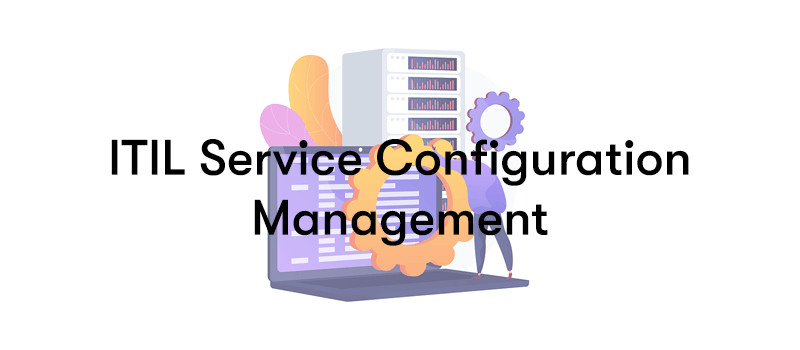ITIL 4, or IT Infrastructure Library 4, is a widely recognised framework for IT service management. Service Configuration Management is one of the practices defined within ITIL 4, aimed at ensuring that accurate and reliable information about the configuration of services, systems, and infrastructure components is available to support effective service management. Service Configuration Management is basically understanding how things are joined up, understanding what software is deployed on which server or who has access to which service. The practice is also closely linked to the IT Asset Management practice, which supplies much of the data used in Service Configuration Management.
ITIL Service Configuration Management
In the fast-paced world of IT service management, organisations strive to deliver reliable and efficient services while maintaining control over their complex IT infrastructure. ITIL 4, a widely adopted framework, provides a comprehensive set of practices to achieve these goals. Among these practices, Service Configuration Management plays a crucial role in ensuring accurate and reliable information about the configuration of services, systems, and infrastructure components.
Effective Service Configuration Management allows organisations to establish and maintain a robust configuration management system (CMS) that serves as the cornerstone of their IT operations. By implementing ITIL 4 Service Configuration Management, businesses can gain unprecedented control over their IT landscape, reduce risks, optimise change management, and enhance service quality.
In this blog post, we will delve into the world of ITIL 4 Service Configuration Management. We will explore its objectives, components, and the significance it holds in managing the configuration of IT services. So, whether you are an IT professional seeking to improve your organisation's configuration management practices or a curious learner eager to understand this vital ITIL 4 practice, this blog will provide you with the insights you need.
What is ITIL Service Configuration Management?
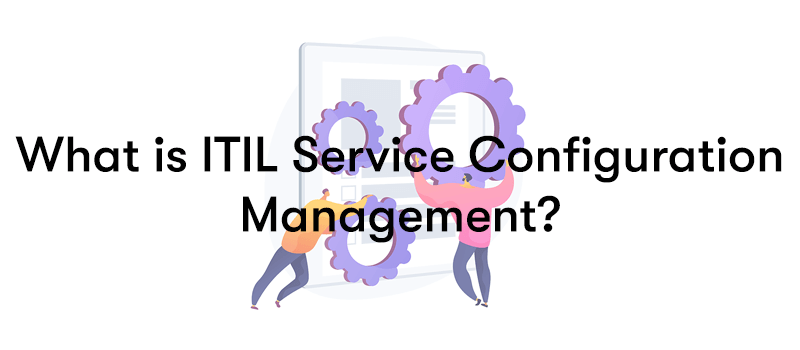
Service Configuration Management (SCM) focuses on maintaining and managing the configuration items (CIs) within an organisation's IT infrastructure. CIs can include hardware, software, documentation, processes, and any other component that is necessary to deliver IT services. SCM aims to establish and maintain a reliable configuration management system (CMS) that enables effective decision-making, risk management, and change management within an organisation.
Why is ITIL Service Configuration Management Important?
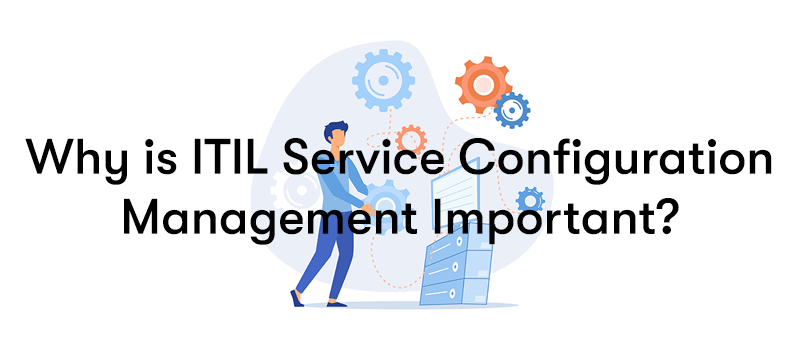
ITIL 4 Service Configuration Management is important for several reasons:
Accurate and Reliable Configuration Information
Service Configuration Management ensures that accurate and reliable information about the configuration of services, systems, and infrastructure components is available. This information is crucial for making informed decisions, implementing changes, and resolving incidents and problems effectively.
Risk Management
Misconfigurations in the IT infrastructure can lead to service disruptions, security vulnerabilities, and other risks. Service Configuration Management helps organisations identify and mitigate these risks by maintaining control over the configuration of CIs. It ensures that changes are properly evaluated, approved, and implemented, minimising the potential impact on services.
Change Management
Configuration Management is closely linked to change management/enablement processes. By maintaining a clear understanding of the current configuration and its relationships, Service Configuration Management supports effective change planning, impact analysis, and risk assessment. It helps organisations implement changes smoothly while minimising the risk of unintended consequences.
Incident and Problem Resolution
Accurate configuration information is vital when troubleshooting and resolving incidents and problems. With Service Configuration Management, organisations can quickly identify the relevant CIs, understand their dependencies, and determine the potential impact of changes. This facilitates faster incident resolution and root cause analysis, leading to improved service availability and reliability.
Compliance and Audit
Many organisations operate in regulated industries with specific compliance requirements. Service Configuration Management helps organisations demonstrate compliance by maintaining accurate documentation of configuration items and their relationships. It supports audits by providing a reliable source of configuration data, ensuring that organisations can meet regulatory and contractual obligations.
Service Planning and Optimisation
Service Configuration Management provides organisations with insights into the structure and composition of their IT infrastructure. This information is valuable for service planning, capacity management, and optimisation initiatives. By understanding the configuration landscape, organisations can make informed decisions about resource allocation, performance optimisation, and service improvement.
Knowledge Management
Configuration information serves as a valuable knowledge base for the IT organisation. It provides a historical record of changes, incidents, and problem resolutions. Service Configuration Management ensures that this knowledge is captured and made available for future reference, enabling efficient knowledge sharing, learning, and continuous improvement.
What is the Objective of Service Configuration Management?
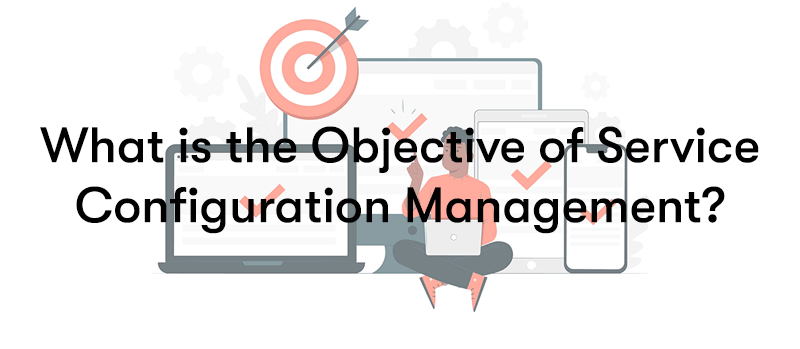
The objective of ITIL 4 Service Configuration Management is to ensure that accurate and reliable information about the configuration of services, systems, and infrastructure components is available to support effective service management. The primary goal is to establish and maintain a configuration management system (CMS) that enables organisations to effectively manage and control their configuration items (CIs) within the IT infrastructure.
The specific objectives of ITIL 4 Service Configuration Management include:
Configuration Identification
The objective is to identify and define the CIs that make up the IT infrastructure. This involves establishing a systematic approach to naming, labelling, and uniquely identifying each CI to ensure proper tracking and control.
Configuration Control
The objective is to establish and maintain control over changes to the configuration of CIs. This includes implementing processes and procedures to evaluate, approve, and implement changes in a controlled manner. Configuration control ensures that changes are managed with minimal disruption and risk to services.
Configuration Status Accounting
The objective is to capture and maintain accurate and up-to-date information about the status and attributes of CIs throughout their lifecycle. This information includes details such as version numbers, relationships, dependencies, and other relevant data that provide a comprehensive view of the configuration.
Configuration Verification and Audit
The objective is to regularly verify and audit the configuration data to ensure its accuracy, completeness, and compliance with defined standards and policies. Configuration audits help identify discrepancies, inconsistencies, or unauthorised changes within the configuration and facilitate corrective actions.
Configuration Reporting and Documentation
The objective is to generate and maintain documentation and reports related to the configuration of CIs. This includes creating configuration records, baseline documentation, and reports on configuration changes, status, and compliance. Configuration reporting and documentation support effective decision-making, communication, and compliance with organisational requirements.
Relationship Management
The objective is to establish and maintain accurate information about the relationships and dependencies between CIs. Understanding these relationships helps in assessing the impact of changes, diagnosing incidents and problems, and optimising service performance.
What Are the Components of Service Configuration Management?
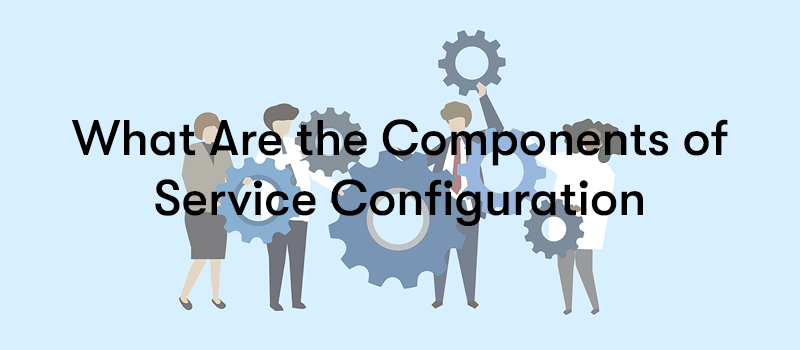
Service Configuration Management aims to establish a reliable configuration management system (CMS) that provides a centralised repository for storing and managing configuration data. The CMS consists of tools, databases, and information that enable organisations to track and control the configuration items (CIs) that make up their IT infrastructure. Some key aspects of ITIL 4 Service Configuration Management include:
Configuration Management System (CMS)
The CMS is a set of tools, databases, and information that is used to manage configuration data. It provides a central repository for storing and maintaining configuration information, such as the relationships between CIs.
Configuration Item (CI)
A CI is a component of the IT infrastructure that needs to be managed and controlled. CIs can range from physical devices like servers and network switches to software applications, documents, and even people. Each CI is uniquely identified and has attributes that describe its characteristics.
Configuration Baseline
A configuration baseline represents the current and authorised configuration of a CI or a set of CIs. It serves as a reference point for future changes and helps ensure that the infrastructure can be restored to a known and stable state if needed.
Configuration Management Plan (CMP)
The CMP is a document that defines the policies, procedures, and responsibilities for implementing and managing SCM within an organisation. It outlines the activities, resources, and tools required to maintain the integrity of the configuration data.
Configuration Control
Configuration control involves establishing and maintaining control over changes to CIs. It includes processes for requesting, evaluating, approving, and implementing changes to the configuration. Change management and change evaluation processes are closely related to configuration control.
Configuration Audit
Configuration audits are conducted to verify the accuracy and completeness of configuration data. They help identify discrepancies, inconsistencies, or unauthorised changes and ensure that the CMS remains up to date and reliable.
Configuration Management Database (CMDB)
The CMDB is a fundamental component of the CMS. It is a database that stores configuration information, including CIs, their attributes, and relationships. The CMDB provides a single source of truth for configuration data and supports various IT service management processes.
What Activities Come Into Play?
ITIL 4 Service Configuration Management involves a range of activities to effectively manage and control the configuration of IT services, systems, and infrastructure components. These activities include:
Configuration Identification
This activity involves identifying and defining the Configuration Items (CIs) that make up the IT infrastructure. It includes establishing naming conventions, labelling, and assigning unique identifiers to each CI. The goal is to have a clear understanding of the components that need to be managed and controlled.
Configuration Control
Configuration control is the process of managing changes to the configuration of CIs. It includes activities such as assessing and evaluating proposed changes, obtaining approvals, and implementing changes in a controlled manner. Configuration control ensures that changes are managed with minimal disruption and risk to services.
Configuration Status Accounting
This activity involves maintaining accurate and up-to-date information about the status and attributes of CIs throughout their lifecycle. It includes recording information such as version numbers, relationships, dependencies, and other relevant data. Configuration status accounting provides a comprehensive view of the configuration at any given time. The key challenge is to ensure that the data in the CMDB reflects the status of the organization’s resources and that this status is correct (meaning there are no unauthorized changes).
Configuration Verification and Audit
This activity ensures that a new or changed IT service, process, plan, or other deliverable matches its design specification and is complete, accurate, and reliable. Verification and audit activities are conducted to validate the accuracy, completeness, and compliance of the configuration data. These activities involve comparing the actual configuration against the expected configuration, identifying discrepancies or inconsistencies, and conducting audits to ensure adherence to defined standards and policies. Verification and audit activities help maintain the reliability and integrity of the configuration data. Auditing is one of the tools of CMDB verification; a resource-demanding planned verification endeavour. It is usually organized and managed as a project and, like any project, should be justified and approved in order to occur. These audits are often combined with IT asset audits.
Configuration Baseline Management
A baseline configuration is the configuration of a product, service, or infrastructure that has been formally reviewed and agreed. It serves as the basis for further activities, such as use, development, and planning. Configuration baselines represent authorised and agreed-upon configurations of CIs at specific points in time. Baselines serve as reference points for managing changes and provide a known and stable state to which the infrastructure can be restored if needed. Baseline management involves creating, maintaining, and updating baselines as the configuration evolves.
Relationship Management
Relationship management focuses on understanding and managing the relationships and dependencies between CIs. It involves capturing and documenting the relationships to determine how changes to one CI can impact others. Relationship management helps assess the impact of changes, troubleshoot incidents and problems, and optimise service performance.
Configuration Reporting and Documentation
This activity involves generating and maintaining documentation and reports related to the configuration of CIs. It includes creating configuration records, documenting configuration changes, generating reports on configuration status, compliance, and performance. Configuration reporting and documentation support effective decision-making, communication, and compliance requirements.
These activities collectively form the core of ITIL 4 Service Configuration Management. By performing these activities effectively, organisations can ensure accurate configuration information, optimise change management, reduce risks, enhance incident and problem resolution, and support overall service quality and performance.
What Are The Benefits of Service Configuration Management?
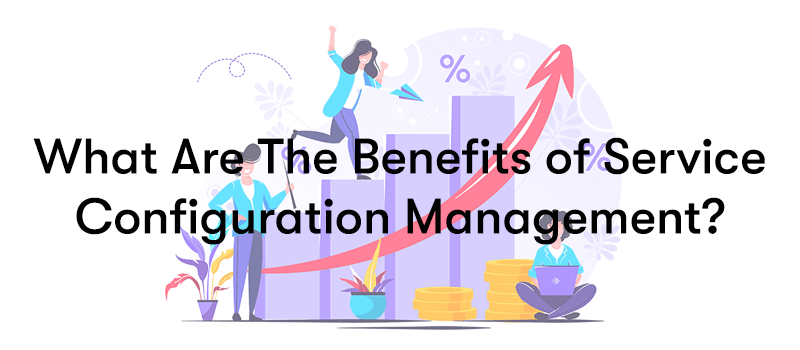
Service Configuration Management offers several benefits to organisations. Some of the key benefits include:
Accurate Configuration Information
Service Configuration Management ensures that organisations have accurate and up-to-date information about the configuration of their IT services, systems, and infrastructure components. This knowledge enables organisations to make informed decisions, plan changes effectively, and troubleshoot incidents and problems more efficiently.
Improved Change Management
By having a clear understanding of the configuration landscape, organisations can better assess the impact of proposed changes. Service Configuration Management provides insights into the relationships and dependencies between configuration items (CIs), allowing organisations to plan and execute changes with reduced risks and minimised service disruptions.
Reduced Service Disruptions
Misconfigurations can lead to service disruptions and outages. By implementing effective Service Configuration Management practices, organisations can minimise the risk of misconfiguration-related incidents. Accurate configuration information and proper change control processes contribute to the stability and reliability of IT services.
Enhanced Incident and Problem Resolution
Quick and accurate resolution of incidents and problems relies on having a comprehensive understanding of the configuration and its relationships. Service Configuration Management enables organisations to identify and isolate the root causes of incidents and problems more efficiently. It helps IT teams pinpoint affected CIs, assess their impact, and restore services promptly.
Compliance and Audit Support
Many organisations operate in regulated industries or have contractual obligations that require compliance with specific standards. Service Configuration Management helps organisations maintain accurate documentation of configuration items and their relationships. This documentation supports compliance efforts and simplifies the audit process by providing a reliable source of configuration data.
Effective Capacity Management
Configuration information is valuable for capacity planning and optimisation. Service Configuration Management allows organisations to analyse the resources allocated to different services and identify areas for improvement. This helps optimise resource allocation, ensure adequate capacity for service delivery, and avoid performance bottlenecks.
Efficient Knowledge Management
Configuration data serves as a valuable knowledge base for the IT organisation. By documenting and maintaining configuration information, organisations can capture insights and lessons learned from past incidents, changes, and problem resolutions. This knowledge can be shared across teams, enabling continuous learning and improvement.
Streamlined Service Planning and Delivery
Service Configuration Management provides a comprehensive view of the IT infrastructure, facilitating effective service planning and delivery. With accurate configuration information, organisations can align services with business needs, identify opportunities for improvement, and make informed decisions about resource allocation and service enhancements.
In summary, Service Configuration Management offers benefits such as accurate configuration information, improved change management, reduced service disruptions, enhanced incident and problem resolution, compliance support, efficient capacity management, streamlined service planning, and efficient knowledge management. These benefits contribute to improved service quality, increased operational efficiency, and better alignment between IT services and business objectives.
Service Configuration Management interfaces with IT Asset Management which supplies much of the data used in Service Configuration Management. Remember that all CI’s are assets, but not all assets are Cis (see our IT Asset Management blogs)
Where Can You Learn More?
If you want to learn more about service configuration management, we offer a one day ITIL® 4 Practitioner: Service Configuration course.
This training course will teach you how service configuration in IT is used to support various IT service management processes, including change management, incident/problem management, release management, asset management, capacity/performance management, and security/compliance.
Please note ITIL® 4 Foundation is a prerequisite for this course.
Final Notes on Service Configuration Management and ITIL
In the fast-paced world of IT service management, effective Service Configuration Management plays a vital role in ensuring accurate and reliable configuration information. Throughout this blog, we've explored the key components, objectives, and benefits of ITIL 4 Service Configuration Management. By implementing this practice, organisations can gain control over their IT infrastructure, reduce service disruptions, optimise change management, and enhance overall service quality.
Accurate configuration information serves as the foundation for informed decision-making, efficient incident and problem resolution, and effective capacity planning. It also supports compliance efforts and streamlines service planning and delivery. With Service Configuration Management in place, organisations can confidently navigate the complexities of their IT landscape and adapt to changing business needs.
By understanding the core activities involved in Service Configuration Management, organisations can establish robust processes for configuration identification, control, verification, and audit. They can harness the power of configuration baselines, relationship management, and comprehensive reporting to optimise their IT operations.
Remember, Service Configuration Management is not a one-time endeavour but an ongoing practice that requires continuous attention and maintenance. Regular updates, accurate documentation, and adherence to best practices are key to maximising the benefits of this discipline.
So, whether you are embarking on the journey of implementing ITIL 4 Service Configuration Management or seeking to enhance your existing practices, the rewards are significant. From improved change management and reduced service disruptions to enhanced incident resolution and compliance support, Service Configuration Management empowers organisations to achieve greater control and efficiency in their IT operations.
As technology evolves and organisations strive to deliver exceptional services, Service Configuration Management remains a crucial practice to master. Embrace the power of accurate configuration information, and unlock the potential to transform your IT infrastructure into a well-controlled and optimised engine that drives business success.
Continue your exploration of ITIL 4 and its practices to unlock the full potential of IT service management. By incorporating Service Configuration Management into your organisational strategy, you can pave the way for a more resilient, efficient, and customer-focused IT landscape.
Thank you for joining us on this journey through the world of ITIL 4 Service Configuration Management. May your organisation thrive with enhanced control and agility as you harness the power of accurate and reliable configuration information.


